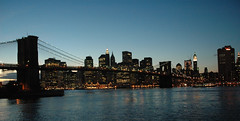Joel Kotkin writes an opinion piece in today's Wall Street Journal in defense of urban sprawl and the growth of suburbs. He feels there is an anti-sprawl bias among urban planning academics and city planning departments who have tried to slow suburban growth. Mr. Kotkin cites statistics that indicate that these anti-sprawl crusaders are failing and suburbia continues to spread like a fungus around the globe.
Perhaps the best-known case of anti-sprawl legislation has been the "urban growth boundary," adopted in the late '70s to restrict development to areas closer to established urban areas. To slow the spread of suburban, single-family-home growth, the Portland region adopted a "grow up, not out" planning regime, which stressed dense, multistory development. Mass transit was given priority over road construction, which was deemed to be sprawl-inducing.
Experts differ on the impact of these regulations, but it certainly has not created the new urbanist nirvana widely promoted by Portland's boosters. Strict growth limits have driven population and job growth further out, in part by raising the price of land within the growth boundary, to communities across the Columbia River in Washington state and to distant places in Oregon. Suburbia has not been crushed, but simply pushed farther away. Portland's dispersing trend appears to have intensified since 2000: The city's population growth has slowed considerably, and 95% of regional population increase has taken place outside the city limits.
This experience may soon be repeated elsewhere as planners and self-proclaimed visionaries run up against people's aspirations for a single-family home and low-to-moderate-density environment. Such desires may constitute, as late Robert Moses once noted, "details too intimate" to merit the attention of the university-trained. Even around cities like Paris, London, Toronto and Tokyo -- all places with a strong tradition of central planning -- growth continues to follow the preference of citizens to look for lower-density communities. High energy prices and convenient transit have not stopped most of these cities from continuing to lose population to their ever-expanding suburban rings.
But nowhere is this commitment to low-density living greater than in the U.S. Roughly 51% of Americans, according to recent polls, prefer to live in the suburbs, while only 13% opt for life in a dense urban place. A third would go for an even more low-density existence in the countryside. The preference for suburban-style living continues to be particularly strong among younger families. Market trends parallel these opinions. Despite widespread media exposure about a massive "return to the city," demographic data suggest that the tide continues to go out toward suburbia, which now accounts for two-thirds of the population in our large metropolitan areas. Since 2000, suburbs have accounted for 85% of all growth in these areas. And much of the growth credited to "cities" has actually taken place in the totally suburb-like fringes of places like Phoenix, Orlando and Las Vegas.|WSJ|[Sub'n Req'd]
I suspect that he is right, which is all the more sad.
I've often thought that communism fails because it expects too much of human nature and capitalism succeeds because it panders to the most base appetites of humans.
That is why we need regulatory agencies to try to balance out the base appetites with some forethought and central planning. The goal is to bring about a prosperous yet fair and sustainable economy. Alas, the Republicans are totally hostile to reasonable regulation and assume the market will always regulate itself. This belief in the market seems almost religious to me in its unquestioned nature.
To my mind, suburban sprawl is another symptom of overpopulation. As population growth continues exponentially, and everyone wants a house and backyard, we will continue to see the growth of suburbia into farmland, wetlands, and wilderness areas.
If we could rein in population growth and develop sustainable energy sources then there would not be a problem with everyone having a house with a backyard.
However, our current patterns of consumption and overpopulation cannot continue unabated. The coming crisis from climate change, the end of cheap oil and the decline of farming productivity (related to the loss of fossil-fuel based fertilizer, cheap fuel for farm equipment and the shift in climate patterns) will make us eventually realize what a horribly myopic race we are and bring on an economic correction that will make the Great Depression look like a bad weekend. Well, that's enough metaphor mixing for now.
Let me conclude by raising a toast to suburbia. Let us enjoy our decadent American lifestyle while it lasts.




No comments:
Post a Comment